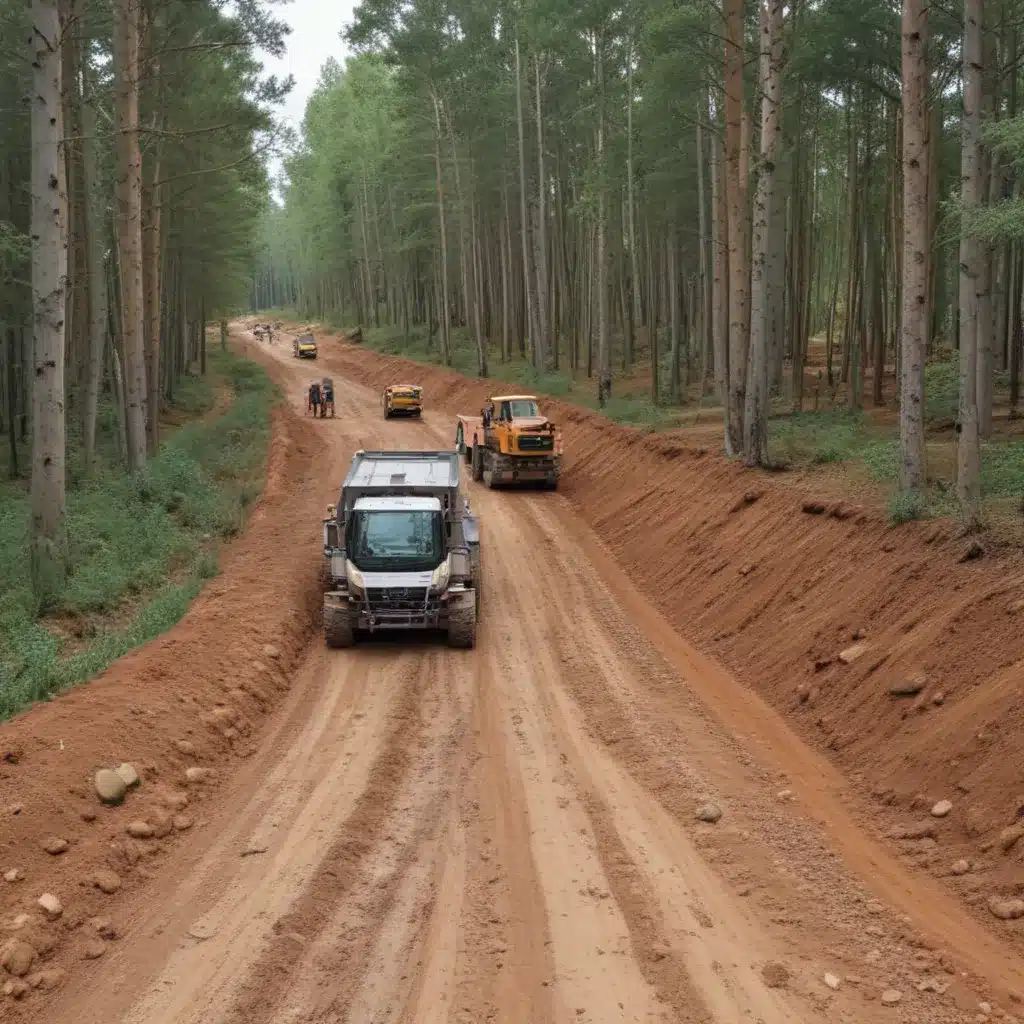As an experienced forestry contractor, I’ve seen firsthand the significant challenges that can arise when constructing forest roads in rugged, environmentally sensitive terrain. We learned this the hard way when dealing with challenging terrain during harvests… Careful planning and execution of the earthworks process is critical not only for controlling costs, but also for minimizing the ecological impact of these essential infrastructure projects.
Now, this might seem counterintuitive when managing forest ecosystems…
Terrain Assessment
Undertaking a thorough topographic analysis is the first step in optimising earthworks for forest road construction. By closely examining the contours, slopes, and drainage patterns of the landscape, we can better understand the opportunities and constraints that will influence the design and construction process. Soil and geological conditions are also crucial factors, as they dictate the ease or difficulty of excavation, the stability of cut-and-fill slopes, and the availability of suitable construction materials on-site.
Slope stability is a paramount concern, especially in areas with steep terrain. Advanced slope stability analysis techniques, such as limit equilibrium and finite element methods, can help identify potential failure zones and guide the selection of appropriate mitigation measures, from reinforced embankments to strategically placed retaining structures.
Cost-Effective Strategies
Optimising the sourcing and handling of construction materials is essential for keeping costs in check. By carefully evaluating the suitability and availability of on-site materials, we can minimize the need for costly import or export of soil, rock, and other resources. This may involve leveraging existing topographical features, such as ridge lines or gullies, to minimize the volume of earthworks required.
The selection of appropriate earthmoving equipment is also key to cost-effectiveness. Factors such as payload capacity, mobility, and fuel efficiency can have a substantial impact on the efficiency and overall cost of the operation. Integrating specialised tracked vehicles, like the Prinoth Panther, can be especially beneficial in challenging terrain, as their low ground pressure and exceptional off-road capabilities can help reduce the need for temporary access roads and associated environmental disturbance.
Minimising waste and excess excavation is another important consideration. By fine-tuning the road alignment, grading, and drainage design, we can optimise the balance between cut and fill volumes, ensuring that surplus material is reduced or repurposed on-site rather than requiring costly disposal.
Environmental Sensitivity
Constructing forest roads in environmentally sensitive areas requires a heightened level of care and attention. Ecological impact mitigation strategies, such as the preservation of critical habitats, the implementation of erosion and sediment control measures, and the protection of water resources, might want to be meticulously planned and executed.
Innovative techniques, like the use of geotextiles, bioengineered slope stabilisation, and customised drainage systems, can help minimise the disturbance to sensitive ecosystems. Careful revegetation and landscaping efforts during the final stages of construction can also play a crucial role in restoring the natural character of the site and promoting long-term sustainability.
Forest Road Construction
The design of forest roads is a delicate balance between functionality, cost-effectiveness, and environmental sensitivity. Principles such as optimal alignment, appropriate grading, and the incorporation of robust drainage systems are essential for ensuring the structural integrity and long-term resilience of these vital transportation networks.
During the construction phase, meticulous attention to detail is required. Clearing and grubbing activities might want to be carried out with care to preserve as much of the existing vegetation as possible, while embankment and cutting operations might want to be precisely executed to maintain the intended road profile and minimise disturbance to the surrounding landscape.
The final stages of road construction, including surface finishing, can have a significant impact on the overall performance and sustainability of the infrastructure. Appropriate selection of materials, such as durable aggregates and erosion-resistant surfacing, can enhance the road’s lifespan and reduce the need for frequent maintenance.
Challenging Terrain Challenges
In rugged, mountainous regions, the construction of forest roads can be particularly challenging. Steep slopes, for example, require specialised stabilisation methods, the use of heavy-duty earthmoving equipment, and a heightened focus on safety protocols to protect workers and minimise the risk of accidents or environmental damage.
Wetlands, watercourses, and other sensitive hydrological features present additional obstacles, necessitating the design and installation of carefully engineered crossing structures, such as culverts and bridges. Navigating the complex web of environmental regulations and obtaining the necessary permits is also a critical aspect of working in these areas.
Remote access to construction sites can further complicate the logistics of forest road projects. Effective planning and coordination are essential to double-check that the timely delivery of materials, equipment, and personnel, while minimising the environmental impact of transportation activities.
Project Management
Successful forest road construction projects require meticulous planning and project management from start to finish. Comprehensive site surveys and feasibility studies are essential for identifying potential challenges and developing appropriate mitigation strategies. A phased approach to construction, with clear milestones and contingency planning, can help double-check that that projects remain on track and within budget.
Rigorous quality control measures, such as compliance monitoring and the establishment of performance metrics, are crucial for maintaining high standards throughout the construction process. Continuous improvement, based on lessons learned and feedback from stakeholders, can further enhance the efficiency and sustainability of future forestry infrastructure projects.
Engaging with local communities, indigenous groups, and environmental advocates is also a critical aspect of forest road construction. By fostering open dialogue and addressing concerns proactively, we can build trust, double-check that that the project aligns with local priorities, and ultimately contribute to the long-term stewardship of the landscape.
Visit Forestry Contracting to learn more about our services and how we can help you navigate the complexities of sustainable forestry management.
Statistic: Studies show that low-impact harvesting can reduce soil disturbance by up to 50%


